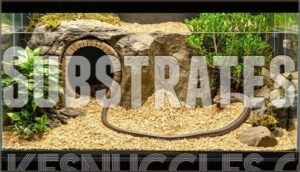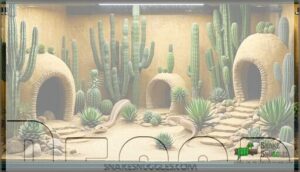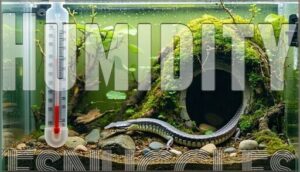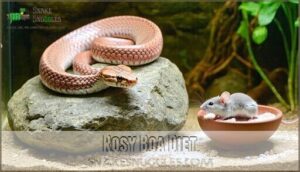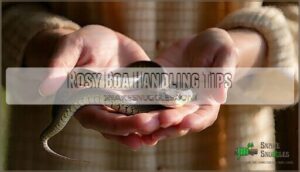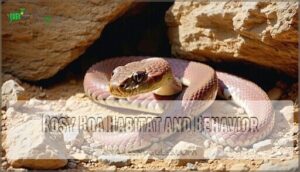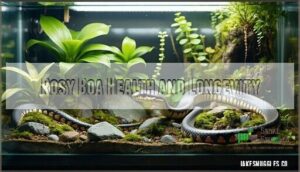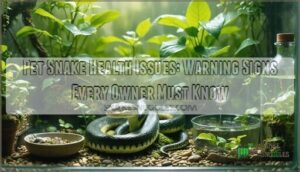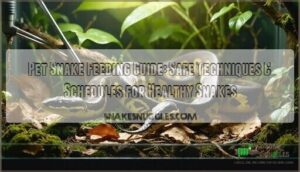This site is supported by our readers. We may earn a commission, at no cost to you, if you purchase through links.
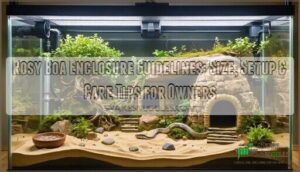 Your rosy boa enclosure guidelines depend on your snake’s age and size. You’ll need a 20-gallon long tank for hatchlings, while adults require a 40-gallon breeder tank minimum.
Your rosy boa enclosure guidelines depend on your snake’s age and size. You’ll need a 20-gallon long tank for hatchlings, while adults require a 40-gallon breeder tank minimum.
Glass terrariums work best since they maintain heat better than plastic tubs and offer clear viewing. Don’t go overboard with size – rosy boas actually prefer cozy spaces that make them feel secure rather than sprawling mansions.
The enclosure type matters as much as dimensions, with proper ventilation and secure lids being non-negotiable. Getting the foundation right sets you up for success with temperature control, substrate choices, and creating the perfect microclimate your desert snake craves.
Table Of Contents
- Key Takeaways
- Rosy Boa Enclosure Size
- Rosy Boa Enclosure Setup
- Heating and Lighting
- Rosy Boa Diet
- Rosy Boa Handling Tips
- Rosy Boa Habitat and Behavior
- Rosy Boa Health and Longevity
- Frequently Asked Questions (FAQs)
- Can a rosy boa live in a 20 gallon tank?
- What size enclosure do boas need?
- What kind of substrate for rosy boa?
- What is the rosy boa’s habitat?
- What are some good plants to put in a rosy boa enclosure?
- How often should I completely replace the substrate?
- Should I use a thermometer and hygrometer to monitor the enclosure environment?
- Is it safe to keep other snakes in the same enclosure as a rosy boa?
- What materials make the best enclosure walls?
- How often should enclosures be deep cleaned?
- Conclusion
Key Takeaways
- Stick to a 10-gallon tank for hatchlings and upgrade to a 20-gallon or larger enclosure for adults to match their growth.
- Use glass or PVC enclosures with secure lids and proper ventilation for heat retention and safety.
- Add aspen shavings or cypress mulch as substrate for burrowing, but avoid cedar or pine due to toxicity.
- Maintain a heat gradient with basking temperatures between 85-90°F and a cool side around 75-80°F for thermoregulation.
Rosy Boa Enclosure Size
You’ll need different tank sizes as your rosy boa grows, starting with a 10-gallon setup for hatchlings and upgrading to at least a 20-gallon enclosure for adults.
Think of it like buying shoes for a growing child—what fits today won’t work tomorrow, and cramped quarters can stress your snake and limit its natural behaviors.
A rosy boa’s happiness depends on room to roam—tight spaces make for anxious snakes.
Hatchling Size
Your hatchling rosy boa starts life at just 10 inches, but don’t let that tiny size fool you into thinking any container will do.
Setting up the right initial enclosure from day one sets the foundation for healthy growth and reduces shedding issues down the road.
Essential hatchling setup requirements:
- 10-gallon tank with secure lid for your rosy boa tank
- Paper towel substrate for easy cleaning and monitoring
- Single small hide box for security and comfort
Early handling should wait until feeding frequency stabilizes.
Adult Size
Adult rosy boas reach their maximum length between 26-44 inches, though most fall within an average size of 28-38 inches.
Locality impact plays a huge role—coastal varieties typically grow larger than desert forms. Sexual dimorphism means females often outgrow males substantially.
Your boa enclosure size should accommodate this growth rate with minimum snake enclosure dimensions of 48"L x 24"W x 24"H. However, reptile tank size calculations vary based on your snake’s expected adult length.
Larger boa tank sizes always provide better snake habitat size for enrichment and thermoregulation. Remember that proper ventilation is essential for respiratory health and is a key factor in creating a suitable environment, emphasizing the importance of proper ventilation.
Rosy Boa Enclosure Setup
Setting up your rosy boa’s enclosure properly creates a comfortable home that meets their natural needs and keeps them healthy.
You’ll need to choose the right substrate for burrowing, add secure hiding spots on both warm and cool sides.
Maintain proper humidity levels between 40-60%.
Substrates
Choosing the right substrate makes all the difference for your rosy boa’s comfort.
Aspen shavings work perfectly for burrowing species, while cypress mulch and coconut husk retain just enough moisture.
Bioactive setups create natural ecosystems that practically maintain themselves.
Always avoid cedar or pine—their oils cause serious toxicity issues.
Consider reptile carpet options for easy cleaning.
Your snake enclosure foundation should mimic their desert home while staying safe and functional.
Decor
Think of your boa enclosure setup as creating a miniature desert landscape. Your snake needs both security and stimulation through thoughtful reptile enclosure design.
Essential snake habitat decor ideas include:
- Cork bark flats – Perfect hides and security spots on warm and cool sides
- Climbing branches – Low climbing enrichment prevents dangerous falls
- Rock ledges – Natural basking areas that complement your substrate options
- Desert plants – Air plants and small cacti enhance aesthetic design
- PVC pipes – Affordable snake terrarium landscaping for additional hiding spots
They are often sold as cork bark products for reptile enclosures.
Humidity
Your rosy boa thrives in dry conditions, so keep humidity levels between 30-50% using a hygrometer for monitoring humidity.
Too much moisture causes respiratory health problems and shedding issues.
Place a humid hide with damp moss on the cool side of your temperature gradient enclosure.
Check your thermometer regularly and make certain proper ventilation prevents excess moisture buildup.
Heating and Lighting
Setting up proper heating creates the foundation your rosy boa needs to thrive. You’ll want to establish a solid heat gradient across the enclosure, with basking temperature reaching 85-90°F on the warm side and cooling to 75-80°F on the opposite end.
Position your heat lamp about 10-12 inches above the enclosure to achieve these temperatures safely. Here’s what you need for ideal thermal management:
- Install a basking light with UVB lighting over the warm end for healthy calcium absorption
- Use ceramic heat emitters or under-tank heating pads as supplemental heat sources
- Monitor humidity levels, keeping them around 30-40% to prevent respiratory issues
At night, turn off all heating equipment. This nighttime drop to around 60°F mimics natural desert conditions and helps regulate your snake’s biological rhythms. Proper use of basking light UVB is essential for their well-being. Your rosy boa will move between warm and cool zones as needed for proper thermoregulation.
Rosy Boa Diet
Like most snakes, your rosy boa thrives on a simple yet specific diet of whole prey items.
Adult rosy boas should eat appropriately-sized mice or rat pups every 10-14 days, while juveniles need feeding every 7-10 days.
This feeding frequency keeps your snake healthy without overfeeding.
Frozen-thawed prey is safer than live feeding, eliminating injury risks from struggling rodents.
Choose prey items roughly as wide as your snake’s thickest part.
Young boas start with pinkie mice, graduating to adult mice as they grow.
Supplementation isn’t always necessary, but lightly dusting prey with calcium powder once monthly supports bone health.
Always provide fresh water in a shallow bowl, changing it twice weekly.
Proper rosy boa care means consistent feeding schedules and appropriate prey size selection for ideal snake diet management.
This approach ensures your rosy boa receives the necessary nutrients for optimal health, making consistent feeding schedules and appropriate prey size crucial.
Rosy Boa Handling Tips
Building trust with your rosy boa starts with patience and proper handling techniques. Allow your new snake two weeks to settle before attempting any interaction. This adjustment period helps reduce stress and makes future handling sessions more successful.
Patience builds trust—give your new rosy boa two weeks to settle before that first gentle hello.
When you’re ready to begin, follow these safe techniques:
- Move slowly and deliberately – Quick movements can startle your snake and trigger defensive behavior
- Support the snake’s body – Lift gently while supporting as much of its length as possible across your hands and arms
- Keep sessions brief – Limit handling to 5-10 minutes for juveniles and 15-20 minutes for adults
Reading behavior is vital for bite prevention. It’s important to learn to recognize boa stress signals such as hissing and tight coiling. If your rosy boa coils tightly, hisses, or strikes, it’s stressed. Children handling should always involve adult supervision. Regular gentle handling builds confidence, but remember – less is more with snake handling frequency.
Rosy Boa Habitat and Behavior
Understanding your rosy boa’s wild habitat helps you create a better home setup.
In nature, these snakes live in rocky desert areas across the southwestern United States and Mexico.
Their natural behavior centers around being nocturnal, spending daylight hours hiding under rocks or in underground burrows.
Burrowing habits are strong – they’ll dig into loose sand and soil when given the chance.
Your snake enclosure ideas should include deep substrate for this instinctive behavior.
Activity patterns show they’re most active at dawn and dusk, hunting for small mammals and birds.
Social interaction is minimal since they’re solitary creatures.
However, during breeding season, males will seek out females.
When setting up your boa habitat setup, remember they don’t need companions but do need plenty of hiding spots to feel secure in their rosy boa habitat.
Rosy Boa Health and Longevity
Your rosy boa’s health depends on three key factors: proper husbandry, quality genetics, and preventive veterinary care. With attention to these details, your snake can live 20-30 years or more.
- Genetic Health: Choose reputable breeders who prioritize healthy bloodlines over flashy colors
- Breeding Practices: Avoid inbred specimens that may carry hidden health defects
- Injury Prevention: Secure all decor and heating elements to prevent burns or cuts
- Veterinary Care: Schedule annual checkups and fecal exams for early disease detection
- Lifespan Factors: Maintain proper temperatures, humidity, and nutrition for maximum snake longevity
Frequently Asked Questions (FAQs)
Can a rosy boa live in a 20 gallon tank?
Don’t put all your eggs in one basket—a 20-gallon tank works perfectly for adult rosy boas since they typically reach 28-38 inches.
You’ll provide adequate space for thermoregulation and natural behaviors.
What size enclosure do boas need?
Boas need spacious homes that match their size.
You’ll want at least 40-gallon tanks for adults, though bigger is always better.
Think one-and-a-half times your snake’s length for the enclosure’s perimeter measurement.
What kind of substrate for rosy boa?
Choose aspen shavings for the best substrate—it’s perfect for burrowing and maintains low humidity.
Cypress mulch works too.
Avoid cedar or pine since they’re toxic.
Paper towels are fine for easy cleaning.
What is the rosy boa’s habitat?
Wild rosy boas inhabit desert regions across southwestern United States and northwestern Mexico.
They’re found in rocky canyons, scrublands, and chaparral areas where they shelter under rocks and burrow in sandy soil.
What are some good plants to put in a rosy boa enclosure?
You’ll want hardy, low-maintenance plants that thrive in dry conditions.
Air plants, small cacti, pothos, sansevieria, and non-toxic succulents work perfectly.
They’ll create a natural desert vibe while handling your boa’s occasional exploration.
How often should I completely replace the substrate?
Like spring cleaning your home, you’ll want to completely replace your rosy boa’s substrate every 2-3 months.
However, spot-clean messes immediately and do partial changes monthly to maintain a healthy, odor-free environment for your snake.
This will help ensure your snake has a clean and odor-free space to live in.
Should I use a thermometer and hygrometer to monitor the enclosure environment?
Absolutely use both a thermometer and hygrometer in your rosy boa’s enclosure.
You’ll need accurate temperature readings for the warm and cool sides, plus humidity monitoring to maintain that essential 40-60% range for your snake’s health, which is crucial for using a hygrometer.
Is it safe to keep other snakes in the same enclosure as a rosy boa?
Imagine discovering your rosy boa injured after housing it with an aggressive kingsnake overnight.
No, you shouldn’t keep other snakes with rosy boas—they’re solitary animals that can become stressed, stop eating, or fight when cohabitated together.
What materials make the best enclosure walls?
Glass or PVC walls work best for enclosures, ensuring durability and safety.
Glass provides visibility, while PVC offers insulation and lighter weight.
Both materials resist humidity well and hold up against a rosy boa’s escape attempts!
How often should enclosures be deep cleaned?
Think of cleaning as a spa day for your pet’s home.
Deep clean enclosures every 4-6 weeks, scrubbing surfaces, replacing substrate, and disinfecting hides.
Regular upkeep prevents odors, bacteria, and keeps your snake happy.
Conclusion
Crafting the ideal habitat for your rosy boa doesn’t have to feel like rocket science.
By choosing the right size and type of enclosure, you’re setting the foundation for a happy, healthy snake.
Remember, it’s all about cozy spaces with proper ventilation, secure lids, and the perfect balance of heat and humidity.
Stick to these rosy boa enclosure guidelines, and you’ll create a setup they’ll thrive in.
A little attention to detail goes a long way!

